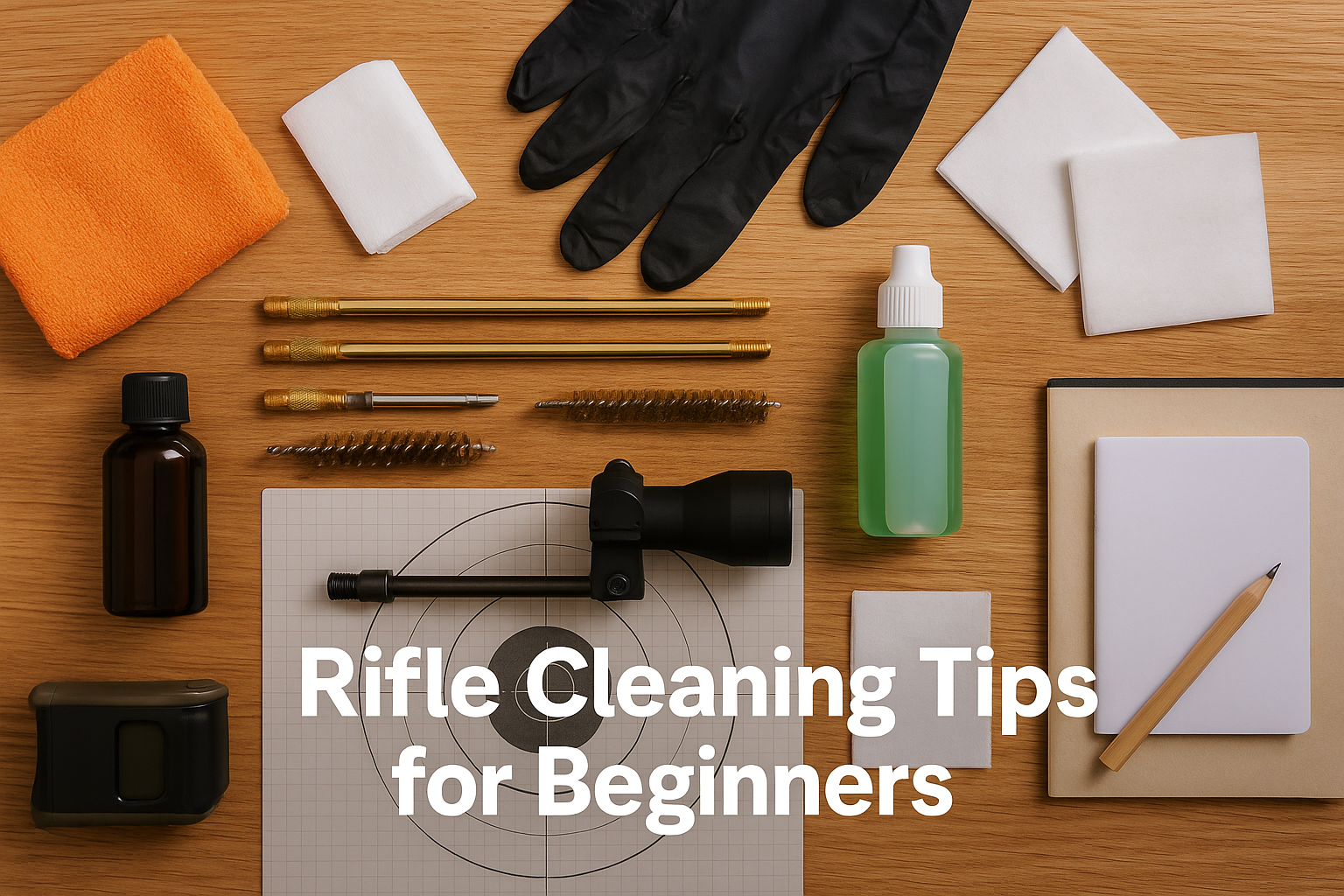
When it comes to shooting whether for hunting, target practice, or tactical use your rifle’s performance depends heavily on how well you maintain it. A clean rifle not only performs better but also lasts longer and keeps you safe. Yet, many beginners underestimate how vital regular cleaning truly is.
In this guide, we’ll walk you through rifle cleaning basics, explain why it’s essential, outline the tools you’ll need, and share step-by-step rifle cleaning tips for beginners so your firearm stays as precise and reliable as the day you bought it.
Table of Contents
Even if your rifle looks fine after a range session, every shot leaves behind carbon, copper, lead, and powder residue inside the barrel and action. Over time, these build up and can cause:
Regular maintenance ensures your rifle fires smoothly, chambers cleanly, and remains safe during every shot.
This depends on how you use it:
Even if your rifle hasn’t been fired, clean it every few months—dust and humidity can still cause oxidation.
Before you start, make sure you have the right tools. Investing in quality cleaning equipment prevents accidental damage.
Choose bronze or nylon brushes depending on your barrel type. These help scrub away carbon and copper fouling inside the bore.
Cotton patches remove loosened fouling and apply solvents and oils evenly through the bore.
Attach these to your cleaning rod for pushing patches through the bore.
A good bore solvent breaks down powder and copper fouling. Some popular choices include:
After cleaning, apply a light layer of oil to prevent rust and ensure smooth action.
Protects your workspace from oil and solvents.
Perfect for scrubbing bolt faces, trigger groups, and hard-to-reach areas.
Used for wiping down parts and removing excess oil.
Holds your rifle securely in place, freeing up your hands during cleaning.
Before touching your rifle, safety comes first. Follow these steps:
Let’s go through a full cleaning routine that applies to most bolt-action or semi-automatic rifles.
Mount your rifle in a cleaning vise or lay it on a padded mat. Keep the muzzle pointing away from you and slightly downward—this ensures solvents don’t run back into the action.
The bore is the heart of your rifle’s accuracy. Start from the chamber end, never the muzzle.
👉 Pro Tip: Always push the brush completely through before reversing to avoid damaging the crown (the edge of the muzzle).
Residue often collects here. Use a chamber brush or cotton swab dipped in solvent to scrub inside, then wipe clean with dry patches.
For semi-automatics, pay extra attention to the feed ramps—they often collect carbon buildup.
Use a nylon brush and solvent to scrub:
Then wipe dry and apply a thin layer of oil. Avoid over-lubrication—too much oil can attract dust and debris.
Unless heavily fouled, the trigger group usually only needs a light brushing and an air blast. Avoid soaking it in solvent, which can remove necessary grease from internal parts.
Apply a few drops of oil to a cloth and wipe all metal surfaces to protect from corrosion. For wooden stocks, use furniture wax or specialized gun stock oil instead of regular gun lubricant.
Once everything is dry and lightly oiled:
Avoiding these will save you from damaging your firearm:
There are two main types of maintenance routines every shooter should know.
Ideal for hunting trips or quick range sessions.
Takes 10–15 minutes:
Performed every few hundred rounds or after a wet or dusty trip.
Takes 45–60 minutes:
Keep rifles in a cool, dry place with low humidity. Consider silica gel packs or a dehumidifier in your gun safe.
Even small fingerprints can lead to corrosion. Wipe your rifle down before putting it away.
A bore guide centers your cleaning rod and prevents solvent from spilling into the action.
Keep a small log noting when you last cleaned the rifle and how many rounds were fired.
Magazines collect dust and unburned powder—disassemble and clean periodically.
After cleaning, inspect scope mounts, action screws, and stock bedding to ensure nothing has loosened.
Each rifle caliber has its quirks when it comes to cleaning.
Scopes add an extra layer of complexity—here’s how to protect them:
For brand-new rifles, many shooters follow a barrel break-in procedure:
This helps smooth out microscopic imperfections in the barrel’s rifling, leading to tighter groups and easier future cleaning.
If you’re unsure when to clean, watch for these signs:
Cleaning should restore smoothness and accuracy. If not, inspect for damaged parts or excessive fouling buildup.
Here are a few all-in-one kits perfect for newcomers:
These kits usually include rods, brushes, patches, and solvents—everything you need to start.
Don’t neglect your cleaning gear. Store brushes and patches in a dry, sealed box, and occasionally wipe your rods with oil to prevent corrosion. Replace brushes that lose stiffness or show fraying—worn tools can scratch your bore.
Cleaning your rifle isn’t just about aesthetics—it’s about reliability, accuracy, and safety. A well-maintained firearm gives you confidence in the field, whether you’re hunting deer at dawn or hitting steel targets at 500 yards.
Beginners often find the process intimidating, but once you follow these steps a few times, it becomes second nature. Treat cleaning as part of your shooting routine—your rifle will thank you with years of dependable service.
For many shooters, the objective lens size is one of the first things they look…
For decades, the 3–9×40 rifle scope has been one of the most iconic optics used…
Tuning a compound bow can feel intimidating, especially if you’re new to archery or don’t…
The world of compound bows is filled with innovation, craftsmanship, and brand loyalty. Among all…
A hunting rifle is one of the most trusted tools in the field. It doesn’t…
Upland bird hunting especially for pheasant and quail is one of the most rewarding pursuits…
This website uses cookies.